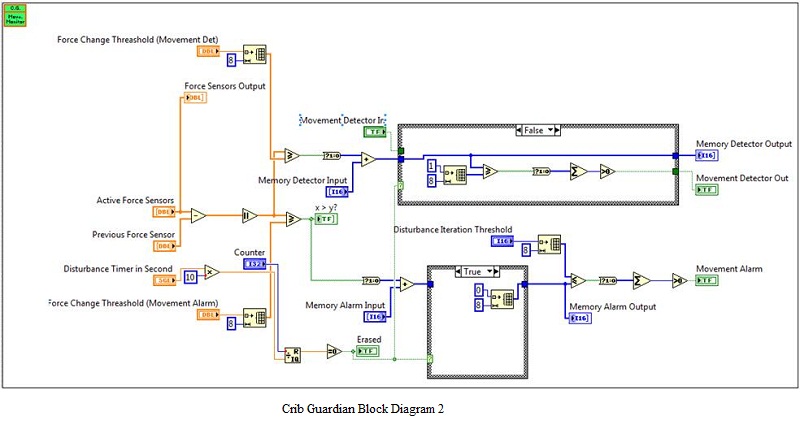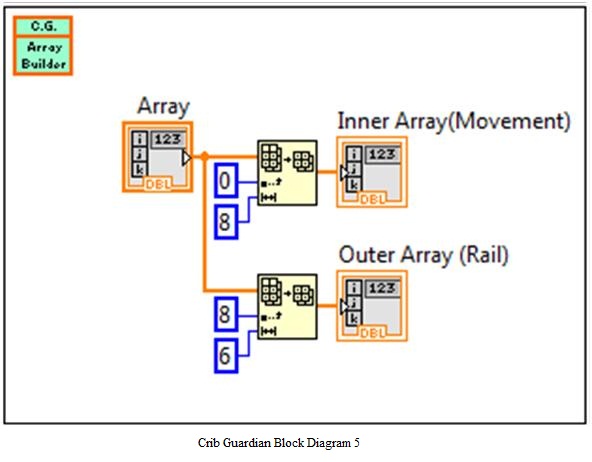- Document History
- Subscribe to RSS Feed
- Mark as New
- Mark as Read
- Bookmark
- Subscribe
- Printer Friendly Page
- Report to a Moderator
- Subscribe to RSS Feed
- Mark as New
- Mark as Read
- Bookmark
- Subscribe
- Printer Friendly Page
- Report to a Moderator
University: The University of Texas at Tyler
Team Member(s): Robert Brumett, Juan Cerda, Justin Erdle, Brady Ross
Faculty Advisors: Drs. David Beams, Hector A. Ochoa
Email Address: dbeams@uttyler.edu, hochoa@uttyler.edu
Country: US
Project Information
Title: Crib Guardian
Description:
Crib Guardian monitors the movements of young children and babies in cribs and alerts caregivers of abnormal movements. The monitoring system consists of three modules: sensing, analysis, and notification.
Products:
Multisim 11.0 (used for circuit simulation); Ultiboard 11.0 (circuit-board layout); LabVIEW 2011 (data acquisition and analysis); NI USB-6008 (digital I/O); NI USB-6011 (analog input),
The Challenge:
Every year thousands of babies and toddlers are injured by falls from cribs, resulting in hospitalization of an average of nearly 9,500 small children and babies [1]. Approximately 180,000 children under two years of age were treated in an emergency room in the almost twenty year study period due to an injury related to cribs, playpens, and bassinets, and it has been estimated that head injuries account for 66 percent of the incidents that require a visit to the emergency room for treatment [1].
Various market solutions for baby monitoring systems have been developed in order to reduce the risk of serious injury to small children and babies while in baby cribs. There are at present several prominent companies supplying systems to this market, including Angelcare, BabySense, and Tommee Tippee. The monitors at the high end of the price range include devices from Angelcare and Tommee Tippee that couple video surveillance with a sensor pad. These devices are priced at $300. The low end of the price spectrum (typically between $100 and $130) is occupied by devices from Respisense, Snuza, and Angelcare. Movement monitors are employed in combination with sound monitors for some of these systems. The Snuza and the Respisense monitors detect motion via a device that clips to the baby’s diaper and are priced at $129.99 and $99.95, respectively.
The challenge is to design a much less-invasive, competitively-priced system for monitoring the movements of young children and babies in cribs and alerting caregivers to potentially-dangerous situations.
[1] E Yeh, L. Rochette, L. McKenzie, and G. Smith, "Injuries Associated With Cribs, Playpens, and Bassinets Among Young Children in the US, 1990-2008," Pediatrics, vol. 127, no. 3, March 2011.
The Solution:
Crib Guardian was developed as a solution to the challenge stated above. Crib Guardian consists of three major modules: sensing, analysis, and notification.
The sensing module consists principally of an array of 14 force-sensitive resistors (FSRs) mounted between two Plexiglas sheets, each sheet having the width and length of a standard crib mattress. These two Plexiglas sheets are mounted between the mattress and the frame that supports the mattress. Small rubber bumps on the lower surface of the upper Plexiglas sheet rest against the FSRs mounted on the lower sheet; forces are thus transmitted from the upper sheet to the FSRs. Circular FSRs provide point measurements of force at points interior to the mattress; linear FSRs were used to provide measurements of force along the crib rails. Figure 1 below gives an exploded representation of the sensor-array construction (the linear FSRs were omitted from this view). Operational amplifier buffers convert the resistances (which are inversely proportional to normally-applied forces) into voltages. These voltages are read by a USB-6011 data-acquisition module under LabVIEW control.

The analysis module consists of a LabVIEW virtual-instrument (VI) program which takes the raw analog output voltages from the sensing module and uses algorithms to classify the force profile and determine whether an alert should be issued. The notification module consists of a wireless link that transmits alerts generated by the analysis module to a portable receiver. The receiver of the notification module uses a combination of a vibration motor, buzzer, and various light-emitting diodes (LEDs) to alert caregivers and indicate the abnormal condition detected. The vibration motor and buzzer are used as auxiliary methods of notification. A USB-6008 data-acquisition module is used to interface the LabVIEW code of the analysis module to the transmitter of the notification module. Crib Guardian has three types of alert notifications: caution, child at rail, and danger. The caution notification (indicated by a yellow LED) is a low-level alert which indicates that the child is moving within the confines of the crib. This alert makes the user aware that the child is not asleep. The child at rail notification (blue LED) is used to alert the caregiver that the child is near the edge of the crib. The edges of the crib are a potential danger as the child could suffocate if he or she become trapped between the rail and the “baby bumper.” Also, a child standing at the rail could attempt to climb over the railing. The highest alert level is the danger notification (red LED) which is activated if the child begins to jump or to bounce vigorously near the rail. It may appear wasteful or redundant to include two separate USB data-acquisition modules. However, the combination of these two was the simplest solution based on equipment available. The USB-6008 had inadequate analog I/O (without multiplexing), but the USB-6011 had only four digital I/O lines, limiting the number of possible alert codes (each digital I/O line activated a specific LED). Figure 1 below shows the connection of the DAQ modules to the hardware of Crib Guardian.

Figure 3 below is a photograph taken during the development of the force-sensing system. Four force-sensing resistors are visible (appearing as gray circular regions with surrounding black rings) between the Plexiglas sheets. Also visible in the center of each FSR are the rubber bumps that transmit normal forces from the upper Plexiglas sheet to the FSRs. Op amp buffers are mounted on the prototyping board.
The various algorithms contained in Crib Guardian were programmed in LabVIEW 2011 and may be executed from any computer that has a fully-licensed version of the software. In addition to the final version of Crib Guardian, there were a number of developmental versions which provided the development team with additional information for test and validation. Figure 4 below shows a screen image from a development version that displayed output voltages of a complete 14-sensor FSR array vs. spatial location.
The eight inner bars in Fig. 4 represent the eight central “point” FSRs and the six outer bars represent the six rail-sensing FSRs. Force readings are taken at intervals of approximately 100 milliseconds.
The algorithms for the analysis module were developed utilizing LabVIEW. The main program is discussed in detail within the prototype design and fabrication section. Figure 6 shows the main program which analyzes the sensor outputs in order to make a decision. The main program consists of the alarm monitor module, presence monitoring, rail monitoring, and movement monitoring algorithms.
The following are more images from the project:





- Mark as Read
- Mark as New
- Bookmark
- Permalink
- Report to a Moderator
This is the best idea ever!
